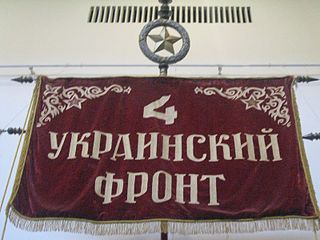
The 4th Ukrainian Front was the name of two distinct Red Army strategic army groups that fought on the Eastern Front in World War II.

The 2nd Guards Tatsinskaya Tank Corps was a tank corps of the Soviet Union's Red Army that saw service during World War II on the Eastern Front of Europe. The unit's most notable moment was in the raid on Tatsinskaya during Operation Little Saturn in World War II. After the war, it continued to serve with the Soviet occupation forces in Central Europe. It was originally the 24th Tank Corps. The formation had approximately the same size and combat power as a Wehrmacht Panzer Division, and less than a British Armoured Division had during World War II.

The Leningrad Military District is a military district of the Armed Forces of the Russian Federation. In 2010 it was merged with the Moscow Military District, the Northern Fleet and the Baltic Fleet to form the new Western Military District. In December 2022, Defense Minister Sergey Shoigu proposed to reestablish it along with the Moscow Military District, a decision confirmed in June 2023 by Deputy Chief of the General Staff Yevgeny Burdinsky. On December 17, 2023 Vladimir Putin announced plans to recreate the Leningrad Military District as a reaction to Finland joining NATO. The district was formally reconstituted on February 26, 2024 by a Presidential Decree.
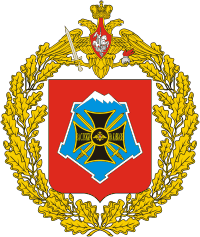
The North Caucasus Military District was a military district of the Russian Armed Forces from 1992-2010. Before 1992 it had been part of the Soviet Armed Forces since 1918. In 2010 it became the Southern Military District and lately also included the Black Sea Fleet and Caspian Flotilla.
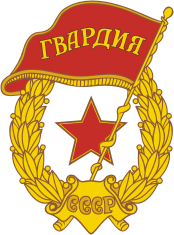
The 90th Guards Tank Division was a division of the Soviet Army, and then of the Russian Ground Forces.
The 85th Leningrad-Pavlovsk Red Banner Motor Rifle Division was an rifle division of the Soviet Red Army converted to a motorised formation in 1957. It was originally formed in 1941 as the 85th Rifle Division from the 2nd Guards People's Militia Division of the Leningrad People's Militia. The 85th Division was part of the Russian Ground Forces until it was reorganised as the 32nd Separate Motor Rifle Brigade in 2009. In 2016, the 32nd Separate Motor Rifle Brigade was reorganised as the 228th Motor Rifle Regiment of the 90th Guards Tank Division.

The 2nd Guards Tank Army was a large military formation of the Red Army and later the Soviet Army, now part of the Russian Ground Forces of the Russian Federation.
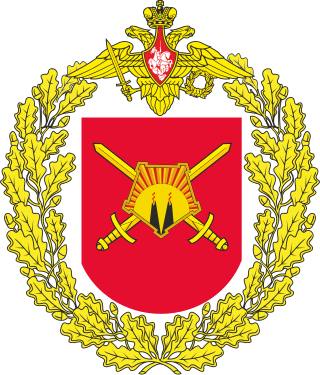
The 39th Separate Guards Red Banner Motor Rifle Brigade is a mechanized infantry brigade in the Russian Ground Forces. Originally formed as the Blagoveshchensk Fortified Region of the Soviet Union's Red Army in 1932, it became the basis for the 2nd formation of the 342nd Rifle Division and took part in the Soviet invasion of Manchuria. During the Cold War, it was reformed as the 56th Motor Rifle Division and later re-designated as the 33rd Separate Motor Rifle Division. In 2009, it was downsized and reorganized into the 39th Separate Motor Rifle Brigade as part of the 2008 Russian military reform.
The 3rd Shock Army was a field army of the Red Army formed during the Second World War. The "Shock" armies were created with the specific structure to engage and destroy significant enemy forces, and were reinforced with more armoured and artillery assets than other combined arms armies. Where necessary the Shock armies were reinforced with mechanised, tank, and cavalry units. During the Second World War, some Shock armies included armoured trains and air–sled equipped units.

The 22nd Mechanized Brigade is a formation of the Ukrainian Ground Forces. It traces its origins to the 66th Guards Rifle Division, originally a formation of the Red Army and later of the Soviet Ground Forces.
The 12th Guards Uman Orders of Lenin Red Banner and Suvorov Tank Division was a tank division of the Soviet Ground Forces. It drew its history from the World War II 16th Tank Corps. It was redesignated successively as 12th Guards Tank Corps (1943) and 12th Guards Tank Division (1946).

The Soviet order of battle for Operation Uranus details the combat units of the Soviet forces that fought in Operation Uranus, the Soviet strategic counteroffensive that led to the encirclement of the German troops in Stalingrad. The order of battle lists units present on 19 November 1942, the day the operation began, from north to south.
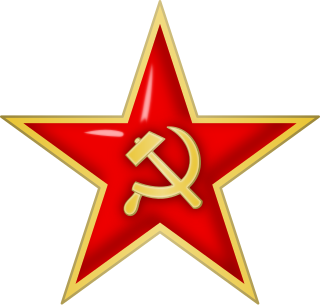
The 5th Shock Army was a Red Army field army of World War II. The army was formed on 9 December 1942 by redesignating the 10th Reserve Army. The army was formed two times prior to this with neither formation lasting more than a month before being redesignated.
The 78th Tank Division was a division of the Soviet Ground Forces, active from 1965 to the 1990s. It was originally established in 1949 as the 15th Tank Division, from the 78th Heavy Tank Self-Propelled Regiment. It gained the 78th designation in 1965. It was part of the 1st Army Corps from 1960, and was based at Ayaguz from 1970. Anatoly Kvashnin commanded the division from 1982 to 1987. In 1991, on the fall of the Soviet Union, the 78th Tank Division was serving at Ayaguz, Kazakh SSR, in the Turkestan Military District. In March 1992 it became part of the Kazakh Ground Forces, and soon after became the 78th Mechanized Division.
The 17th Guards Rifle Division was an infantry division of the Red Army during World War II. It was created on March 17, 1942, from the first formation of the 119th Rifle Division, in recognition of that division's stalwart defense against German Army Group Center in the Battle of Moscow, and in the subsequent strategic offensive that threw the German forces back from the capital. It became the 123rd Guards Motor Rifle Division in 1957 and converted into the 129th Guards Machine-Gun Artillery Division in 1989. In 2001, it was converted to the 17th Guards Motor Rifle Division and became the 70th Guards Motor Rifle Brigade in 2009. The brigade was reorganized as the 114th Guards Motor Rifle Regiment of the reformed 127th Motor Rifle Division in 2018. The regiment is currently based in Ussuriysk.
The 11th Guards Airborne Division was the name of two separate airborne divisions of the Soviet Airborne Troops. The division was first formed in late 1943 from three airborne brigades and did not see action before its conversion to the 104th Guards Rifle Division nearly a year later. The division was formed a second time in 1948 from a regiment at Ryazan and was disbanded in 1955.
The 22nd Guards Tank Division was a tank division of the Soviet Army. The division traced its lineage back to the World War II 7th Guards Airborne Division, which became the 115th Guards Rifle Division after the end of the war. In 1957, the 115th became the 22nd Guards Tank Division. The division was based in the small military town of Novoye, which was quickly renamed Cherkaske after the Cherkassy honorific title of the division. From May 1957, it was part of the 6th Guards Tank Army, relocated from the Transbaikal. The division's 223rd Tank Regiment was transferred from the 16th Tank Division of the 6th Guards Tank Army, formerly stationed in Mongolia. The division was maintained as a high strength cadre division, not ready for combat. It was disbanded in 1990 to make room for the 93rd Guards Motor Rifle Division, which had been withdrawn from Hungary.
The 61st Army was a field army of the Red Army and the Soviet Ground Forces. It was created in 1941 and disbanded in 1945. It took part in Operation Bagration and the Riga Offensive of 1944.
The 111th Tank Division was a Tank division of the Soviet Union's Red Army and after 1946, the Soviet Army. The division was formed in the summer of 1941 in the Soviet Far East from the tank regiment of a motorized division that had been reorganized into a motor rifle division, and had thus lost its tank regiment. The division never fought in combat and was in reserve during the Soviet invasion of Manchuria. Postwar, the division continued its garrison duty in the Far East. The 111th was renumbered as the 16th Tank Division in 1955.
The 209th Rifle Division was formed as an infantry division of the Red Army after a motorized division of that same number was destroyed in the first weeks of the German invasion of the Soviet Union. It served through nearly the remainder of the war on a quiet sector in Transbaikal Front, mostly as part of 36th Army. During July 1945, in the leadup to the Soviet invasion of Manchuria, it was transferred to 17th Army, still in Transbaikal Front. This Army was in the second echelon of the invading forces and saw very little, if any, actual combat, but the division was nevertheless given a battle honor. It had been disbanded by mid-1946.









